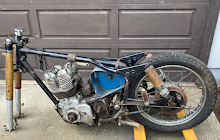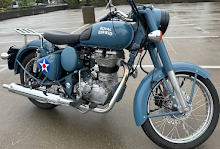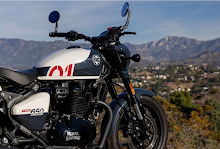 |
| It's the kind of memo you never want to get from your boss. |
V.T. Mountford was in no mood for excuses on Feb. 5, 1963. As Royal Enfield's Joint Managing Director in Britain, he wanted answers, and fast.
"During my visit to India serious complaints were made that drawings of component parts, which we have supplied, were either incomplete or not accurate in that they do not agree with the actual components to which they refer," he wrote.
India was manufacturing more and more of the parts to make the Royal Enfield Bullet. That partly India-made motorcycle became the long-lived and beloved Bullet that ultimately would save the Royal Enfield brand after the company went out of business in Britain.
But, in 1963, Mountford was demanding to know why the parts then still being made in Britain and shipped to India didn't resemble the Bullet plans drawn up by the British themselves.
India had given him a long, and woeful, list of discrepancies. A few examples:
No finish specified. No heat treatment specified. Two holes in bottom of the casquette not shown on drawing.
"When was the spindle cap altered from a flat side to a radius and why were Enfield India not informed of this modification?" Mountford wanted to know.
"The biggest (fork) diameter has been increased... when was this done and why was Enfield India not advised?
"When was relief added to the brake pedal and why was Enfield India not advised?
"Similarly when was the off set of the crank increased... and why was Enfield India not advised?
"We are supplying two different brake shoes neither of which is to the... drawing.
"On the drawing the tappet cover stud holes are shown drilled through whereas in fact on the component they are blind.
"When was the material changed... and why was Enfield India not advised?
The list went on and on. And so did the scolding. Mountford finished with this:
"You will appreciate from the above that Enfield India are finding tremendous difficulty when they come to manufacture parts according to our drawings, as they then find that they do not agree with the actual components.
"It is essential that we immediately check all drawings for components which we are still supplying to them to ensure that these are up-to-date and agree in all respects with the actual components and give all the information required."
The remarkable catalog of misfit bits is part of the Reg Thomas Archive of internal company memos, correspondence with dealers, and other letters now available on the website of the Royal Enfield Owners Club (UK).
They make interesting reading. Of course, you have to join the club to access the archive.
In the Reg Thomas Archive you can find the reply Mountford received Feb. 12, 1963 from Reg Thomas himself.
Reg Thomas was Royal Enfield's chief designer, head of the Drawing Office, and he described himself as "very perturbed by the list of complaints."
In fact, Reg Thomas was good and steamed.
After all, only recently had his Drawing Office even been asked to notify India of alterations in drawings. In several instances no one at the factory had told the Drawing Office of changes; how could it have told Enfield India?
Royal Enfield in Britain had no "schedule" of the Bullet as it was being made in India (it was a version obsolete in Britain), Reg Thomas complained. All he had to go on was a list of the parts Britain supplied. Who knew what drawings India had, or still needed?
And, besides, Thomas noted, many of the drawings were so old they were made before it was the practice to specify particulars of heat treatment or finish.
With a little hunting around you can find the memo Mountford wrote in answer to S.V. Raghavan of Enfield India on Feb. 15, 1963. Mountford supplied Reg Thomas's corrected drawings, where needed, and provided Thomas's explanations in cases where they were not.
Some of the discrepancies were immaterial. Perhaps a shape was slightly changed for the convenience of the foundry, or a bore varied slightly as the punch tool wore.
Fork tubes that showed up in India with increased width were made for Royal Enfield's 250cc Crusaders (not the 350cc Bullet) and must have been sent to India in error.
In other instances the drawings were in fact correct to the parts as supplied. In another case India had, in fact, been notified of a change.
The two mysterious, but innocent, holes that appeared in the bottom of the casquette were to accommodate a steering lock made available in Britain, but not in India.
Mountford ended the memo to India with the suggestion that Enfield India advise in what order it intended to begin manufacturing additional bits of the Bullet. He could then have the relevant drawings checked to make sure they were up to date.
S.V. Raghavan of Enfield India replied, thanking Mountford for the suggestion.
"I have asked Sri Muralikrishna to prepare a list of the work numbers for which we have got manufacturing plans and as soon as it is ready, I shall arrange to forward the same to you," he wrote.
The process of transplanting Royal Enfield's Bullet in India was not seamless. Lovers of today's Royal Enfields are lucky they stuck to it.


























No comments:
Post a Comment